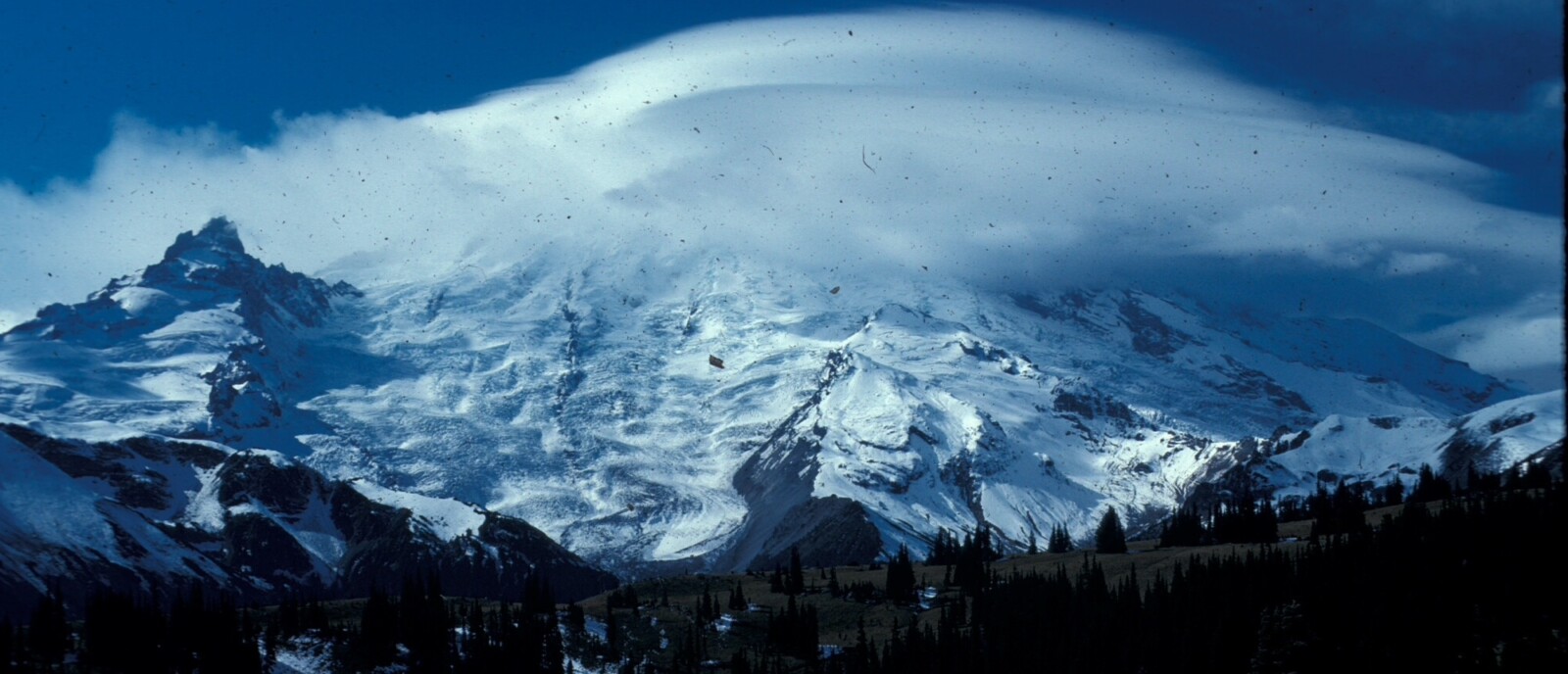By the time my husband and I arrived at Paradise to ski with the children, a lenticular cloud had formed over the top of Mount Rainier. These clouds are recognizable from afar as the UFO-shaped formations that often sit atop mountain ranges, an indication of dangerously turbulent air. Pilots take care to avoid them.
From almost directly below, a vantage point that was entirely new to me, the cloud resembled an umbrella. Its graceful arc buffered us from the wind, leaving us in a pocket of absolute stillness, and I had the sense that we had entered a state of suspended animation. Alone on the trail that morning, the sun breaking from clear skies to the east, the only sounds were of our breath and the faint trickle of melting snow—the occasional cry of a jay. Meanwhile, above us, the winds raged.
In the center of turmoil, there is often a small space for peace. When Kansas farmer Will Keller found himself in the center of a tornado that would, miraculously, leave him unscathed, he described the space as being “as still as death,” the same uncanny state found in the eye of a hurricane or the center of an eddy, perhaps even in a powerful riptide if a swimmer is wise enough not to fight it.1 Stillness is always there at the center.
The Stoics knew this to be true. They knew that, of the body, mind, and spirit, the mind alone is ours to control. Cultivating mental clarity—this stillness of thought and being—is central to the Stoic practice. In his Meditations, Roman Emperor Marcus Aurelius wrote often of his struggles to release himself from the grip of past regrets and future concerns, to focus on the only thing that was in his control: the present moment and his own reactions to whatever the fates would foist upon him. “Entrust the future to Providence and embrace whatever will happen,” he reminded himself. “Concentrate on doing what is in your control now by exercising reverence, justice, wisdom, and all the virtues in your present circumstances.” He wrote of the Greek philosopher Empedocles, who believed we should strive to be like “a sphere rejoicing in its perfect stillness,” the competing forces of love and strife in balance with one another.2
Be still. This is always the exhortation, no matter the religion or philosophy. Naturalists worship in the silent temple of the forest. The contemplative traditions seek to access the God consciousness through meditation. In the Hebrew Bible, God is described as a “still small voice” in the wilderness, a voice that can only be heard by those who have quieted themselves enough to hear it (1 Kings 19:12 KJV).
I have been quieting myself in the mountains these last few days, listening for God and the memory of my father’s voice, for the silence of acceptance that things simply are as they are and not as I might wish them to be. Despite my study of stillness, despite the wisdom of philosophers and theologians, despite the countless examples nature has provided to instruct me, I have struggled to access this state in anything more than a transient way since my father’s death. But I’m making progress.
In a journal entry from Christmas Day in 1856, Henry David Thoreau reflected on nature’s ability to buoy the human spirit: “Take long walks in stormy weather or through deep snows in the fields and woods,” he instructed himself. “Deal with brute nature. Be cold and hungry and weary.”3
So as I mark the anniversary of my father’s death, I submit to the wild and let it exhaust me. I grow weary with the kind of effort that I can only yearn for in my easy life at home, the kind of exertion that only allows me to focus on each moment as it arrives: cutting a new path through fresh snow, slowing to catch my breath. Listening. Quieting.
My focus is ever forward. I never once turn to look at my trail of ash and bone.
- Alonzo A. Justice, “Seeing the Inside of a Tornado,” Monthly Weather Review 58, no. 5 (1930): 205, https://journals.ametsoc.org/mwr/article/58/5/205/89618/SEEING-THE-INSIDE-OF-A-TORNADO.
- Marcus Aurelius, Meditations 12.3.
- Thoreau, The Journal of Henry David Thoreau, 1837–1861, ed. Damion Searls (New York, NY: New York Review, 2009), 425.
